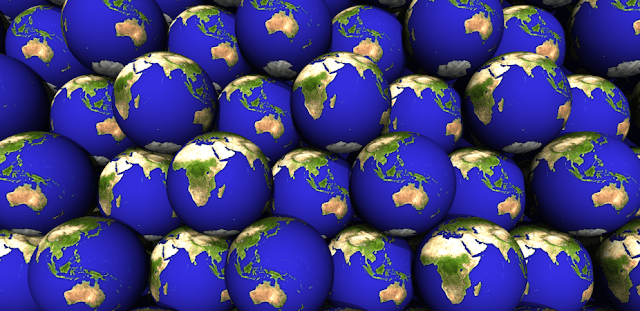Quantum mechanics is born when parallel worlds collide
 |
| Quantum mechanics is born when parallel worlds collide |
Quantum mechanics is born when parallel worlds collide:
In a radical paper distributed for the current week in Physical Review X, we (Dr Michael Hall and I from Griffith University and Dr Dirk-André Deckert from the University of California) propose that parallel universes are genuine, as well as that they are not exactly parallel – they can "impact". In our hypothesis, the connection between close-by universes is the wellspring of the greater part of the peculiar components of quantum mechanics that are uncovered by investigation.
- Numerous universes in existing understandings
The presence of parallel universes in quantum mechanics is not another thought in itself – they are a component of one of the main understandings of quantum mechanics, the 1957 "numerous universes translation" (MWI).
Presently quantum mechanics is the most generally relevant and fruitful physical hypothesis ever, so you may ask why it needs translating. There are two reasons.
Initially, its formalism is greatly remote from regular experience. It is altogether in view of a "wavefunction" which resembles a wave, with the exception of that it lives not in normal three-dimensional space but rather in a boundless dimensional space.
Second, the supposed Bell connections, which can be tentatively measured utilizing inaccessible quantum frameworks beginning from a typical source, abuse the standard laws of neighborhood circumstances and end results.
This infers the wavefunction formalism can't be supplanted by anything in customary space.
There are a few contending translations of quantum mechanics and every one gives a very extraordinary depiction of a definitive sort of reality. Be that as it may, every depiction is significantly interesting somehow, due to the oddness of quantum mechanics itself.
The MWI has been reprimanded for the way that it doesn't characterize absolutely when a perception happens. Along these lines it is ambiguous about what number of universes there are at any given time, and every world is fairly fluffy in its properties, being depicted by a wavefunction.
Likewise, on the grounds that distinctive results occur with various probabilities, the MWI needs to hypothesize that diverse universes have distinctive "weights" – a few universes are more critical than others despite the fact that they are altogether expected to be genuine.
At long last, once they are made, these diverse universes don't communicate, so a few pundits say they are absolutely speculative and fill no need.
- Many interfacing universes:
Our new hypothesis likewise includes numerous universes however there the likeness to the standard MWI closes. Initially, we propose a settled, albeit genuinely huge, number of universes. These exist persistently through time – there is no "fanning".
Second, our universes are not "fluffy" – they have definitely characterized properties. In our approach, a world is indicated by the correct position and speed of each molecule in that world – there is no Heisenberg instability rule that applies to a solitary world. For sure, if there were just a single world in our hypothesis, it would develop precisely as per Newtonian mechanics, not quantum mechanics.
Third, our universes do connect and that association is the wellspring of all quantum impacts. In particular, there is an appalling power of an exceptionally specific kind, between universes with about a similar arrangement (that is, having almost a similar position for each and every molecule). This "interstitial" compel keeps close-by universes from regularly coming to have a similar setup, and tends to make adjacent universes veer.
Fourth, every one of our universes is similarly genuine. Likelihood just enters the hypothesis on the grounds that an eyewitness, comprised of particles in a specific world, does not know for beyond any doubt which world she is in, out of the arrangement of all universes. Thus she will allot rise to likelihood to each individual from that set which is perfect with her encounters (which are exceptionally coarse-grained, in light of the fact that she is a naturally visible gathering of particles). Subsequent to playing out an investigation she can take in more about which world she is in, and accordingly preclude an entire host of universes that she already thought she may be in.
Putting the majority of the above together gives our hypothesis – the Many Interacting Worlds way to deal with quantum mechanics. There is nothing else in the hypothesis. There is no wavefunction, no exceptional part for perception and no key refinement amongst plainly visible and minuscule.
By the by, we contend, our approach can recreate all the standard elements of quantum mechanics, including twin-opening obstruction, zero-point vitality, boundary burrowing, eccentrics and the Bell relationships said above.
- Suggestions and applications
We call our hypothesis an "approach" instead of an "understanding" in light of the fact that for any limited number of universes our hypothesis is just an estimation to quantum mechanics. This gives the energizing probability that it may be conceivable to test for the presence of these different universes.
The capacity to inexact quantum development utilizing a limited number of universes could likewise be exceptionally valuable. In particular, it could be to show sub-atomic flow, which is essential for understanding concoction responses and the activity of medications.
Quantum mechanics has dependably been a perplex in view of the unpretentious yet profound ways it digresses from Newtonian mechanics. That these deviations could be because of a fragile association of basically Newtonian universes with "adjacent" parallel universes is an altogether new answer for the quantum confound.
For us at any rate there is nothing inalienably improbable in the thought, and for fanatics of sci-fi it makes those plots including correspondence between parallel universes not exactly so implausible all things considered.

